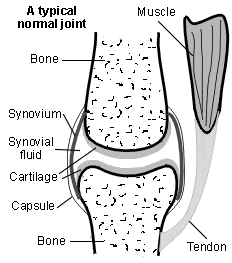Arthritis
Arthritis, meaning inflammation of the joints, is very common. It affects both adults and children. There are many causes and a variety of factors can lead to the development of arthritis.
Arthritis may affect just one joint, a few joints or many joints. Each cause of arthritis tends to have a typical pattern in terms of which joints are affected and the age of people most likely to be affected.
Understanding joints

A joint is situated where two bones meet. Joints allow movement and flexibility of various parts of the body. The movement of the bones is caused by muscles which pull on tendons that are attached to bone. Cartilage covers the end of bones. Between the cartilage of two bones that form a joint there is a small amount of thick fluid called synovial fluid. This lubricates the joint, which allows smooth movement between the bones.
The synovium is the tissue that surrounds a joint. Synovial fluid is made by cells of the synovium. The outer part of the synovium is called the capsule. This is tough, gives the joint stability, and stops the bones from moving out of joint. Surrounding ligaments and muscles also help to give support and stability to joints.
Causes of arthritis
The two most common types of arthritis are osteoarthritis and rheumatoid arthritis. However, there are many different causes/types of arthritis including:
- Septic arthritis
- Ankylosing spondylitis
- Gout
- Calcium pyrophosphate deposition
- Psoriatic arthritis
- Reactive arthritis
- Juvenile idiopathic arthritis
Symptoms
The symptoms of arthritis vary depending on the nature and severity of the underlying cause. The symptoms include:
- Joint pain, tenderness and stiffness
- Restricted movement of the joints
- Warmth and red skin over the affected joint
- Weakness and muscle wasting around the joint
Diagnostic studies may include:
- X-rays can reveal if osteoarthritis from degenerative changes is causing your knee pain. The diagnosis of osteoarthritis is made on history, physical examination & X-rays
- There is no blood test to diagnose Osteoarthritis (wear & tear arthritis)
Conservative treatment options
Conservative treatment options refer to management of the problem without surgery. Some conservative treatment measures for knee osteoarthritis include:
- Activity Modification and Limitations
- Weight Reduction
- Anti-inflammatory Medications
- Physical Therapy
- Orthotics such as canes, braces or insoles
- Injection of steroid and analgesic into the knee joint




